Website: www.sednet.org
Compiled by: Marjan Euser (marjan.euser@deltares.nl)
Subscription Service: SedNet Secretariat (marjan.euser@deltares.nl)
Disclaimer: SedNet is not responsible for faults due to incorrectness of info in this newsletter.
Previous issues: www.sednet.org
CONTENTS
Moving Sediment Management Forward – The Four SedNet Messages
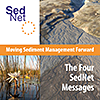 SedNet started in 2002 as a Thematic Network on contaminated sediment, funded by the European Commission. Since 2005, SedNet has continued independently with partners from organisations representing science, management and administration. SedNet broadened its scope to cover all aspects of sediment, from the river to the sea.
SedNet started in 2002 as a Thematic Network on contaminated sediment, funded by the European Commission. Since 2005, SedNet has continued independently with partners from organisations representing science, management and administration. SedNet broadened its scope to cover all aspects of sediment, from the river to the sea.
During the last decade SedNet has organised eight international conferences. Two Round Table events brought together international experts from several European river basins.
Based on this experience and associated discussions, the SedNet core group identified four key messages related to sediment management and these are presented in the brochure “Moving Sediment Management Forward”.
The four key messages can be condensed to one overarching message: Sediments are an integral part of nature and aquatic systems; they are an important resource which needs protection and targeted management.
This brochure was prepared to promote the four key messages at European and national level. The reader is encouraged to make use of it. Enjoy reading the brochure, and SedNet will be happy to discuss sediment management directly with you!
Several case studies exemplify the key messages:
– Case Danube (pdf)
– Case Elbe (pdf)
– Case Meuse (pdf)
– Case Rhine (pdf)
– Case Venice Lagoon (pdf)
– Dredged Material Management (pdf)
Next SedNet Conference in 2015 in Kraków, Poland
Recently theme and date for the 9th International SedNet conference were defined.
The title of the conference is “Solving societal challenges; working with sediments“. Date of the conference is 23-26 September 2015.
Following is a preliminary list of topics that will be addressed during special sessions and lecture sessions:
– Understanding sediment fluxes and budgets on a river basin scale
– Restoring sediment continuity (WFD)
– Valuing sediments and their services
– Sediment quality and society
– Best practices in sediment management
– Dredged material management in rivers and lakes
– Building with dredged material
– Sediment management in mountainous regions
– Sediment in historical and recent mining areas
– Sediment issues Poland
The event will be hosted and co-organised by AGH University of Science and Technology, Kraków, Poland.
In autumn a Call for Abstracts will be disseminated. Deadline for submission of abstracts will be January 2015. Please mark your diary!
Developments membership SedNet Steering Group
The SedNet Steering Group is pleased to announce that this spring a new member from the UK joined the team: Professor Adrian Collins – Rothamsted Research, UK.
Professor Collins has worked for over 20 years researching diffuse pollution, including sediment, from agriculture or additional sectors and its mitigation, focussing specifically on landscape or catchment scale studies and national scale extrapolation and scenario analyses. Whilst he has worked on quantifying individual aspects of catchment sediment budgets, and especially sediment sources using tracing procedures, his recent work has moved towards examining sediment impacts on aquatic ecology in the context of the WFD and assessing the efficacy of specific mitigation options supported by water quality policy using both empirical and modelling approaches. Some of his recent work has devised a candidate revised list of ‘basic measures’ for delivering the WFD in England and Wales and a national cross sector screening tool for identifying those water bodies where agricultural sediment and nutrient inputs are dominant compared to those from other sources and sectors. In the past, Professor Collins has re-written guidance for farmers on the use of riparian buffers for diffuse pollution mitigation in England and Wales in response to the EU CAP Health Check. He has recently led the development of a national scale framework for targeting the mitigation of agricultural sediment losses across England and Wales for the benefit of fish and macro-invertebrates, which can be used to help inform catchment-specific sediment management and pressure reduction targets. Professor Collins is currently leading the Demonstration Test Catchment (DTC) research platform on the Hampshire Avon and Tamar rivers in southern England which is testing suites of on-farm measures for reducing diffuse pollution including sediment and nutrients to protect aquatic ecology and help deliver WFD. He is also assistant director of the newly funded Sustainable Intensification Platform (SIP) in England and Wales exploring opportunities and risks for on-farm sustainable intensification at landscape scale.
Reuse of dredged material as a way to tackle societal challenges
Discussion article in the Journal of Soils and Sediments, by Jos Brils, Pieter de Boer, Jan Mulder and Elmert de Boer.
Sediment is a natural resource that provides the foundation for living, working and building in lowland delta areas. A sustainable society, therefore, reuses dredged material as a valuable resource. Such reuse matches perfectly to the philosophy of a circular economy. However, it is not yet a common practice.
| In order to open a window of opportunity for entrepreneurs to create innovative, realistic market potential options for large scale reuse of dredged material, it is recommended to: | |
| • | Improve knowledge about, and recognition of, the importance of sediment in its role of supporting functions and delivering (ecosystem) services in delta (and other similar) areas; |
| • | Use that knowledge to overcome bottlenecks for management (juridical as well as economic) to the reuse of dredged material. The desire to better couple supply and demand could be the starting point for a new, less complex, set of rules and procedures that can be tailored to regional situations. This will also create more space for entrepreneurship; |
| • | Make use of the ecosystem services concept to define the societal value of dredged material reuse; for example, how it can be integrated into a circular economy; |
| • | Use new projects and programmes, such as the European Commission’s Horizon 2020 programme (European Commission 2011), for experimentation, innovation and practical demonstration of the potential of the reuse of dredged material and other sediment resources. |
Read more: http://link.springer.com
SETAC Passive Sampling Methods Workshop papers
The 6 articles resulting from the SETAC Technical Workshop organised in spring 2014 are now published open access in the Special Series: Passive Sampling Methods for Contaminated Sediments, appearing in Integrated Environmental Assessment and Management (April 2014, Volume 10, Issue 2). Open access means that these articles are immediately free to read, download, and share at: http://onlinelibrary.wiley.com.
This effort represented an unprecedented collaboration of the international community of PSM developers, practitioners, and decision-makers to reach consensus on their role in improving management of contaminated sediments.
Contact:
Jennifer Lynch, Publications Manager
SETAC | 229 South Baylen Street, 2nd Floor | Pensacola, Florida, 32502
Tel: +1 (850) 469 1500 x 109 | Email: jennifer.lynch@setac.org
Marker Wadden – a ‘sediment engine’ building nature
Markermeer (‘lake Marken’), in the direct vicinity of Amsterdam is a deteriorated 700 km² turbid lake with severe ecological problems.
NGO The Society for Nature Monuments initiated project ‘Marker Wadden’: to improve water quality and productivity of the lake by removing large quantities of fine sediment from the bottom of the lake and use the ecologically lifeless sludge as building material. This works both ways: the bottom of the lake would come to life again and it would produce nutrient-rich wetlands. The arising islands in turn would also literally come to life as shown in this artists’ impression:
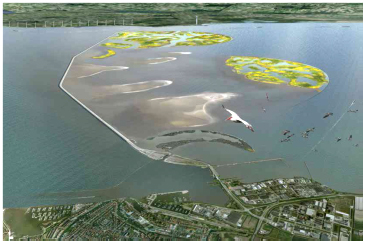
The approach is unique and has never been applied on this scale anywhere in the world. In short: it is a new innovation in Dutch hydraulic engineering: “building with nature!”
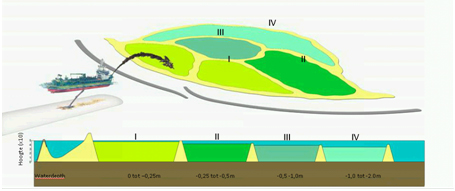
‘Sediment engine’ – the technique explained…
By digging large ‘tidal’ channels at the right spot, the yoghurt-like sludge, which is now in a thin layer over some 500 square km of the bottom, would slide into the depth. A suction dredge will pump it to the mud fields and swamps on the lee side of an artificial reef. The ‘tidal’ channels would encircle the swamp, which keeps transport costs as low as possible.
Each time that nature (wind and water) moves the sludge into the tidal channels and fills them up, the next construction step can be made.
The building process will lead to a better understanding of the reef like constructions, intended to immobilize the sludge on the lee side. It is a learning process, intended to stimulate and try out innovative solutions and adjusting them in a step by step approach.
Contact
The Society for Nature Monuments in the Netherlands is trying to find participating partners / authorities and organizations with similar sludge and dredging problems in estuaries, harbours and river- or lake basins.
If you have similar problems, innovative solutions or are interested in room for experiment or to exchange knowledge, please contact the Society for Preservation of Nature Monuments (Natuurmonumenten)
phone +31 35 655 99 33 – www.markerwadden.nl – info@markerwadden.nl
Promoting Integrated Sediment Management (PRISMA)
Waterways in the 2 Seas Programme Area are increasingly faced with environmental challenges. At the same time healthy and maintained waterways are the basis for social and economic activities. To be able to meet the environmental, economic and social requirements, the maintenance and quality of waterways will have to improve. The project Promoting Integrated Sediment Management aims to identify sustainable sediment management techniques, through various pilot projects and cross-border cooperation that is focussed on three core areas:
• Activity package 1: actions and investments to develop and to test adapted sediment methods to improve the dredging process.
• Activity package 2: actions and investments to develop and test innovative methods for the treatment of sediment.
• Activity package 3: actions and investments to improve and promote the reuse of dredged sediment.
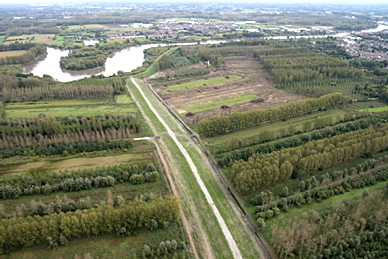
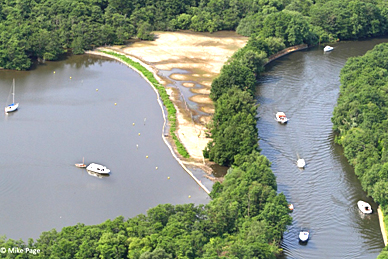
The partnership comprised of Waterwegen en Zeekanaal (BE), Broads Authority (UK), Water Board of Schieland and Krimpenerwaard (NL) and Armines acting through Centre de Douai (FR). The diverse nature and origin of the partner organisations adds complementary experiences and expertise to the partnership.
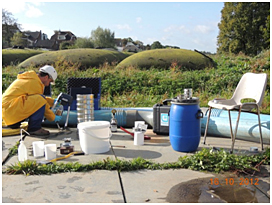
Through a series of pilot projects carried out by the partners’ organisations a range of different dredging vessels were trialled in different environments and with different methods of sediment transport. The treatment of sediment was investigated, ranging from natural lagooning and the use of geotextile bags to dewater sediment, to the stabilisation and solidification of dredged sediment for the use in civil engineering applications. A sediment decision model was developed to assess the beneficial reuse potential of each specific type of sediment, based on particle size distribution and other geomechanical parameters. Finally various beneficial reuse options were assessed, for example agricultural reuse, habitat creation, floodbank strengthening and floodbank construction.
Overall the PRISMA project was successful in investigating the three core activity packages. For the partner organisations, PRISMA achieved to overcome many challenges and to identify solutions that can be utilised in the years to come. The individual pilot reports and overarching activity reports are available on the PRISMA website: www.prisma-projects.eu
William Coulet, PRISMA project manager for the Broads Authority.
PRISMA is partly financed by the European Union, European Regional Development Fund.
EUROPE-INBO 2014 Conference on the implementation of the WFD
The next and 12th “EUROPE-INBO 2014” international conference, organized by the “Group of European Basin Organizations for the Implementation of the European Water Framework Directive – WFD”, will take place, at the invitation of the Romanian Authorities on 12-15 November 2014,
in Bucharest, Romania.
This meeting, within the new context drawn by the European Commission “Blueprint”, will be organized around a preparatory workshop and 4 roundtables dealing with the updated issues of the field Implementation of the EU-WFD and other European water-related Directives.
Topics that will be dealt with: means for better integration of the processes, new measures to cope with the main challenges that are non-point source pollution, hydro-morphology, adaptation to climate change, prevention of droughts and floods, the need to get the stakeholders more involved in the implementation of these measures in the field, etc.
A preparatory workshop will take place on 12 November in the afternoon, dealing with River Restoration and Natural Water Retention Measures. It will aim to exchange on the practices used by the various Member States, to highlight the multiple benefits of these approaches, and to prepare recommendations on the way of implementing them. They will be presented at a plenary session the following day; this workshop is organized with the support of the European Centre for River Restoration (ECRR) and of the National Agency for Water and Aquatic Environments (ONEMA, France); this work will be published later on.
For further details like: Call for Papers, registration, technical visit, simultaneous translation etc. see www.inbo-news.org
1-5 September 2014: 15th World Lake Conference (WLC15), Perugia, Italy: “The Mirrors of the Earth – Balancing Ecosystem Integrity and Human Wellbeing”, organised by ILEC and USMA.
www.wlc15perugia.com
3-5 September 2014: River Flow 2014 – International Conference on Fluvial Hydraulics, Lausanne, Switzerland.
http://riverflow2014.epfl.ch
9-10 September 2014: Workshop BEST – Durability of geo-constructions containing stabilised/solidified contaminated soils or sediments, Stockholm, Sweden.
Organised by the Swedish Geotechnical Institute (SGI) and Luleå University of Technology (LTU). Please register any eventual interest in enrolling by sending an e-mail at your earliest convenience, however no later than the 5th of June 2014, to Josef Mácsik, LTU/Ecoloop, josef.macsik@ecoloop.se
15-18 September 2014: The 17th International Riversymposium has an overarching theme of ‘Large River Basins’. There is hardly a better location to hold this conference than in Canberra in the Murray-Darling Basin – where much of Australia’s A$13 billion water reform implementation and large basin planning has occurred since 2007.
http://www.riversymposium.com
17-19 September 2014: 4th International Symposium on Sediment Management (I2SM), Ferrara, Italy
http://i2sm.remtechexpo.com
17-19 September 2014: 3th International Conference on Sustainable Remediation 2014, Ferrara, Italy
www.sustrem2014.com
22-26 September 2014: Littoral 2014 – Facing present and future coastal challenges.
Jointly organized by the Coastal Research & Planning Institute of Klaipeda University Marine Science & Technology Center, the Baltic States Office of EUCC – Coastal and Marine Union and Association Baltic Valley, Lithuania.
http://balticlagoons.net/littoral2014
14-15 October 2014: ESETAC Europe Special Science Symposium (SESSS) on the Bioavailability of organic chemicals: linking science to risk assessment and regulation. Symposium will be held in Brussels.
Programme available at http://sesss10.setac.eu
Deadline for abstract submission: 16 September 2014.
20-21 October 2014: Final SCARCE International Conference: River Conservation under Water Scarcity: Integration of water quantity and quality in Iberian Rivers under global change, to be held in Tarragona, Spain.
Deadline vor abstract submission: 31 July 2014
All information and online inscription can be found at the SCARCE website:www.scarceconsolider.es
12-15 November 2014: 12th International “EUROPE-INBO 2014” Conference
on the implementation of the European Water Framework Directive, Bucarest, Romania
www.inbo-news.org
11-14 December 2014: IAHS/ICCE 2014 international symposium – Sediment Dynamics: From the Summit to the Sea, New Orleans, USA.
www.rnr.lsu.edu/icce2014
12-15 January 2015: Battelle 8th International Conference on Remediation and Management of Contaminated Sediments, New Orleans, Louisiana USA.
www.battelle.org/sedimentscon
8-13 March 2015: ContaSed – International scientific conference on Contaminated Sediments: Environmental Chemistry, Ecotoxicology and Engineering, Switzerland.
ContaSed is co-organised by the Division of Chemistry and the Environment of the European Association for Chemical and Molecular Sciences (EuCheMS) and by Eawag: Swiss Federal Institute of Aquatic Science and Technology. The conference venue will be at Monte Verità the meeting platform of the Swiss Federal Institute of Technology of Zurich (ETH Zurich) near Ascona in Southern Switzerland: www.csf.ethz.ch
Further information: www.contased.org
9-12 June 2015: 13th International AquaConSoil Conference on sustainable use and management of soil, sediment and (ground)water resources, Copenhagen, Denmark
AquaConSoil is organized by Helmholtz Centre for Environmental Research – UFZ and Deltares. Local co-organizer of the event is a consortium consisting of Danish scientists, policy makers, planners and practitioners, headed by the ATV Foundation of Soil and Groundwater.
www.aquaconsoil.org / LinkedIn Group AquaConSoil
22-26 June 2015: IS.RIVERS – International conference Integrative Sciences and sustainable development of rivers – ZABR – Lyon, FRANCE, organised by GRAIE and ZABR
Call for papers will be launched in September 2014; deadline for abstracts submission: 1st December 2014
www.isrivers.org
6-9 September 2015: ECSA 55 – Unbounded boundaries and shifting baselines: Estuaries and coastal sees in a rapidly changing world, London, UK
More info will soon be announced at www.estuarinecoastalconference.com
23-26 September 2015: 9th International SedNet conference Solving societal challenges; working with sediments”, hosted and co-organised by AGH University of Science and Technology, Kraków, Poland.
Call for Abstracts will be disseminated autumn 2014.
www.sednet.org
Disseminated by:
SedNet secretariat:
Mrs. Marjan Euser
Deltares
P.O. Box 85467
NL-3508 AL Utrecht
The Netherlands
E-mail marjan.euser@deltares.nl

